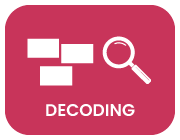< Back to All Decoding Strategies

Phonics
Purpose:
Phonics is the relationship between sounds and the letters used to represent those sounds. Phonics instruction helps readers attach sounds to letters and/or combinations of letters.
How:
- Determine what the reader already knows about phonics
- Look for phonics gaps
- Focus on what the reader needs to know
- Teach phonics in order
- Highlight the sounds within words rather than the sounds in isolation
Did you know?
A sentence without vowels is easier to read than a sentence without consonants. For example:
- Th_ q__ck br_wn f_x j_mps _v_r th_ l_z_ d_g.
- __e _ui__ __o__ _o_ _u___ o_e_ __e _a_y _o_.

Watch:
Feeling Sounds for Phonics Practice from Partners in Reading - San Jose Public Library
Practice:
Nonsense words are a great way to assess a reader's ability to read phonetically. Try this list from Creating Learning Partners Unit 6 Reading Overhead 6.4: Flad, Sind, Hilter, Ricle, Wik, Schlem, Bol, Gramd, Lunp, Drede, Tream
You and the reader can think of words that begin with that sound/that letter (bear, beer, bottle, bathtub...). You can write out the words, perhaps highlighting the B in each word. You can take alphabet cards and spell each word out using the uppercase and lowercase letters. You can make up a silly sentence using the words: The bear was drinking a bottle of beer in the bathtub. Have fun with it.
Excerpted from Answers May Vary Guidebook
Read More:
The Orton-Gillingham Approach to phonics instruction is a multi-sensory method that incorporates listening, speaking, images, writing and movement into basic phonics instruction.
https://www.literacymn.org/orton-gillingham-phonics-approach-video
Rising to the Reading Challenges of Adult Learners: Practitioner's Toolkit Appendix C: Sequencing Phonics Instruction
